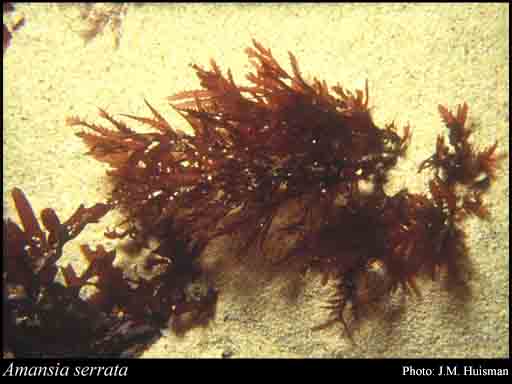- Reference
- Mar.Benth.Fl.S.Australia 394 (2003)
- Conservation Code
- Not threatened
- Naturalised Status
- Native to Western Australia
- Name Status
- Current

Scientific Description
Habit and structure. Thallus dark red-brown, 10–35 cm high, much branched more-or-less bipinnately with the flat pinnae 1–3 cm long and bearing short, alternate, determinate, spinous pinnules 1–2 mm long, with acute tips; main branches 2–4 mm broad with a central thickened midrib 1–2 mm broad, denuded below, wings 2 cells thick, ecorticate; determinate laterals 3–6 axial cells apart. Most fronds are covered on older axes with the bryozoan Bathypora nitens or a didemnid ascidian, and frequently with a hydroid. Holdfast discoid-conical, becoming divided; epilithic. Structure. Apices circinnate, apical cell hemispherical, 15–20 µm in diameter. Axial cells with 5 pericentral cells, 2 lateral on each side and one ventral, with the dorsal-lateral cells each cutting off a pseudopericentral cell and occasionally the ventral cell dividing laterally to form an additional pseudopericentral cell; lateral pericentral cells dividing rapidly to form the wings, with horizontal tiers of cells slightly over-lapping in surface view and appearing as a tier of short cells, cells 40–50 µm in diameter and L/D (3–)4–5. Midrib slender in upper branches, becoming corticated with irregular, thick-walled cells that spread laterally from the midrib. Trichoblasts frequent and prominent at apices of the determinate pinnules, 0.5–1.5 mm long. Cells mostly multinucleate; rhodoplasts discoid.
Reproduction. Gametophytes dioecious. Procarps borne on trichoblasts near apices of pinnules. Carposporophytes with a basal fusion cell and much-branched gonimoblast with clavate terminal carposporangia 35–55(–90) µm in diameter. Cystocarps borne on determinate pinnules, globose, 0.7–1 mm in diameter; pericarp ostiolate, corticated, 3–4 cells thick. Spermatangial organs borne on lower branches of, or replacing, trichoblasts, ovoid, 80–140 µm in diameter, with a sterile basal cell. Tetrasporangial stichidia converted from upper part of determinate pinnules, later with lateral stichidia also, elongate-ovoid to short-lanceolate, compressed, 200–300 µm broad and 450–750 µm long, with tetrasporangia in pairs for 4–7 segments (the older 1 or 2 mature), 60–140 µm in diameter, with cover cells but no further cortication.
Distribution.Flat Rocks, W. Aust., to Robe, S. Aust.
[After Womersley, Mar. Benthic Fl. Southern Australia IIID: 394–395 (2003)]
Distribution
- IBRA Regions
- Geraldton Sandplains, Swan Coastal Plain.
- IBRA Subregions
- Geraldton Hills, Perth.
- IMCRA Regions
- Abrolhos Islands, Central West Coast, Leeuwin-Naturaliste, WA South Coast.
- Local Government Areas (LGAs)
- Cockburn, Dandaragan, Esperance, Greater Geraldton, Irwin, Rockingham, Wanneroo.